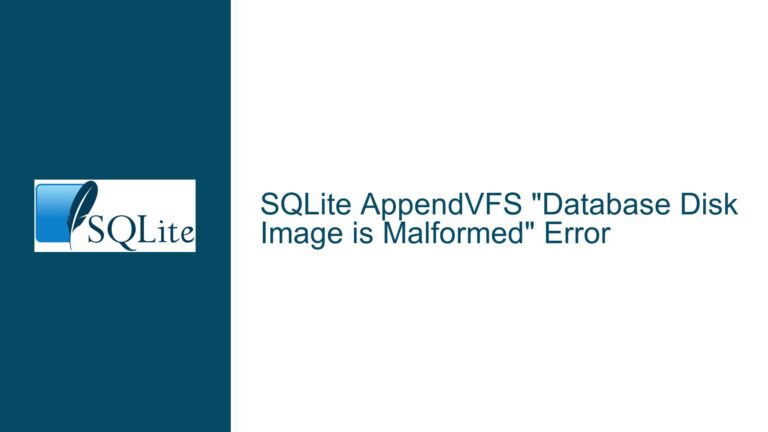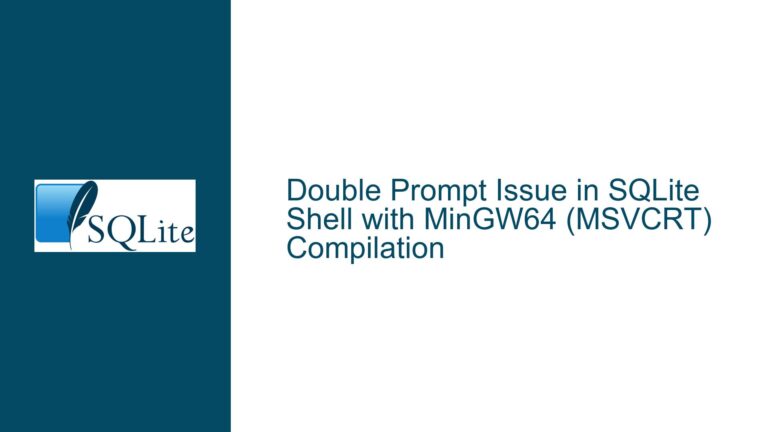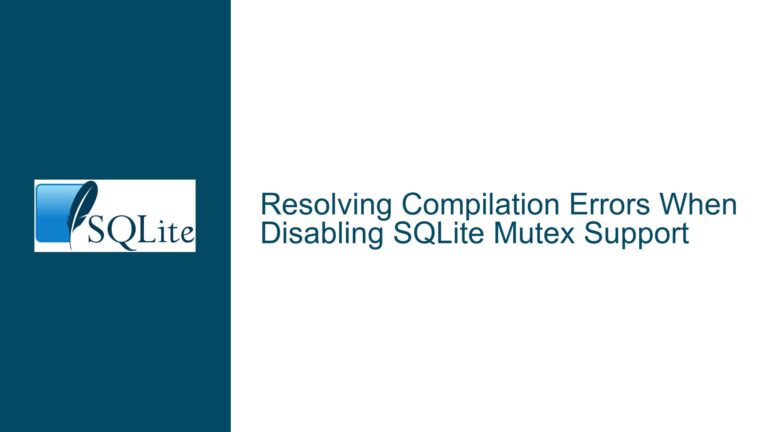Assertion Failure in sqlite3BtreeInsert Due to Corrupt Database
Issue Overview: Assertion Failure in sqlite3BtreeInsert and Database Corruption
The core issue revolves around an assertion failure in the sqlite3BtreeInsert function, which is triggered when attempting to execute a sequence of SQL statements on an SQLite database. The failure occurs because the database has been deliberately corrupted through direct manipulation of the sqlite_master table (also known as sqlite_schema), which stores the database schema. The specific assertion that fails is:
assert(pCur->eState == CURSOR_VALID || (pCur->eState == CURSOR_INVALID && loc));
This assertion is designed to ensure that the cursor state (pCur->eState) is either CURSOR_VALID or, under specific conditions, CURSOR_INVALID. The failure indicates that the database is in an inconsistent or corrupt state, which violates the invariant assumed by the SQLite engine. The corruption is introduced by the following sequence of operations:
- Creating a table
v0with a primary key and inserting a row into it. - Creating two indexes on the
v0table. - Creating a
WITHOUT ROWIDtableawith a unique constraint on a column namedsqlite_stat1. - Enabling the
writable_schemapragma, which allows direct modification of thesqlite_mastertable. - Updating the
rootpagefield in thesqlite_mastertable to an arbitrary value (5), which corrupts the database structure. - Attempting to create a virtual table using a non-existent module (
e), which fails with a "no such module" error. - Updating the
sqlite_stat1column in theatable, which triggers the assertion failure.
The assertion failure is a protective mechanism in SQLite to prevent further damage when the database is in an inconsistent state. The error message "database disk image is malformed" confirms that the database has been corrupted.
Possible Causes: Direct Schema Manipulation and Invariant Violations
The root cause of the issue lies in the direct manipulation of the sqlite_master table, which is a critical system table in SQLite. This table contains metadata about all database objects, such as tables, indexes, and triggers. By updating the rootpage field in this table, the database’s internal structure is disrupted, leading to corruption. The specific causes can be broken down as follows:
Direct Modification of
sqlite_master: TheUPDATE sqlite_master SET rootpage=5statement directly modifies therootpagefield, which stores the page number of the root page for a table or index in the database file. This field is crucial for the SQLite engine to locate and access database objects. Setting it to an arbitrary value (5) breaks the internal linkage, causing the database to become inconsistent.Invariant Violation in
sqlite3BtreeInsert: The assertion failure insqlite3BtreeInsertoccurs because the cursor state (pCur->eState) does not meet the expected conditions. The invariant assumes that the cursor is either valid (CURSOR_VALID) or, under specific conditions, invalid (CURSOR_INVALID). However, due to the corruption introduced by therootpagemodification, the cursor state becomes inconsistent, violating the invariant.Use of
writable_schemaPragmas: ThePRAGMA writable_schema=1statement enables direct modification of thesqlite_mastertable. While this pragma is useful for advanced debugging and testing, it is highly dangerous in production environments. It allows users to bypass SQLite’s protective mechanisms, leading to potential corruption.Non-Existent Virtual Table Module: The
CREATE VIRTUAL TABLE v USING estatement attempts to create a virtual table using a non-existent module (e). This operation fails with a "no such module" error, but the preceding corruption ensures that the database is already in an inconsistent state.Testing and Debugging Flags: The compilation flags used (
-DSQLITE_DEBUG,-DSQLITE_ENABLE_TREETRACE, etc.) enable additional debugging and tracing features in SQLite. While these flags are useful for development and testing, they can expose internal invariants and assertions that are not typically encountered in production builds.Global Variable
sqlite3Config.neverCorrupt: TheCORRUPT_DBmacro, which evaluates to the global variablesqlite3Config.neverCorrupt, is used in assert statements to account for database corruption. By default, this variable is set tofalse, assuming that the database may be corrupt. However, in testing environments, it can be set totrueto bypass corruption checks.
Troubleshooting Steps, Solutions & Fixes: Preventing and Resolving Database Corruption
To address the issue, it is essential to understand how to prevent database corruption and how to resolve it when it occurs. The following steps provide a comprehensive guide:
1. Avoid Direct Schema Manipulation
The most critical step is to avoid directly modifying the sqlite_master table. This table should only be modified by SQLite’s internal mechanisms during schema changes. Direct updates, such as UPDATE sqlite_master SET rootpage=5, should never be performed in production environments. If schema modifications are necessary, use standard SQL statements like CREATE TABLE, ALTER TABLE, and DROP TABLE.
2. Disable writable_schema Pragmas
The writable_schema pragma should be used with extreme caution and only in controlled testing environments. In production, this pragma should remain disabled to prevent accidental or malicious corruption of the database schema. If the pragma must be used, ensure that all modifications are thoroughly tested and validated.
3. Validate Database Integrity
SQLite provides several tools to validate database integrity. The PRAGMA integrity_check statement can be used to verify the consistency of the database file. This pragma checks for issues such as missing or incorrect rootpage values, orphaned pages, and other structural problems. Running PRAGMA integrity_check after schema modifications can help detect and resolve corruption early.
4. Use Assertions and Debugging Flags Wisely
Assertions and debugging flags, such as -DSQLITE_DEBUG and -DSQLITE_ENABLE_TREETRACE, are valuable for development and testing but should be avoided in production builds. These flags can expose internal invariants and lead to assertion failures when the database is in an unexpected state. Ensure that production builds are compiled with standard flags and that assertions are disabled.
5. Handle Corrupt Databases Gracefully
When dealing with potentially corrupt databases, it is essential to handle errors gracefully. The CORRUPT_DB macro and the sqlite3Config.neverCorrupt global variable provide mechanisms to account for corruption in assert statements. However, these should be used judiciously. In production, assume that the database may be corrupt and implement robust error handling and recovery mechanisms.
6. Recover from Corruption
If the database becomes corrupt, several recovery options are available:
Restore from Backup: Regularly back up the database to ensure that a clean copy is available in case of corruption. SQLite’s
VACUUMcommand can be used to create a backup of the database.Export and Rebuild: Use the
.dumpcommand in the SQLite command-line interface to export the database schema and data to a SQL script. Then, recreate the database by executing the script.Use Third-Party Tools: Several third-party tools are available for repairing corrupt SQLite databases. These tools can analyze the database file and attempt to recover data.
7. Test with TH3
SQLite’s Test Harness 3 (TH3) provides comprehensive testing coverage, including tests for corrupt databases. Running TH3 tests can help identify and resolve issues related to database corruption. Ensure that the sqlite3Config.neverCorrupt variable is set appropriately during testing to validate invariants.
8. Monitor and Log Errors
Implement monitoring and logging to detect and diagnose database corruption. Log errors and warnings related to schema modifications, assertion failures, and integrity checks. This information can help identify the root cause of corruption and prevent future occurrences.
9. Educate Developers and Users
Educate developers and users about the risks of direct schema manipulation and the importance of database integrity. Provide guidelines and best practices for schema modifications, testing, and error handling.
10. Apply SQLite Updates
Ensure that the latest version of SQLite is used, as updates often include fixes for issues related to database corruption. The fix for the specific issue discussed in this thread was implemented in commit cd485b302c54aef0, which added the || CORRUPT_DB term to the assert statement in sqlite3BtreeInsert.
By following these steps, you can prevent database corruption, resolve issues when they occur, and ensure the integrity and reliability of your SQLite databases.






